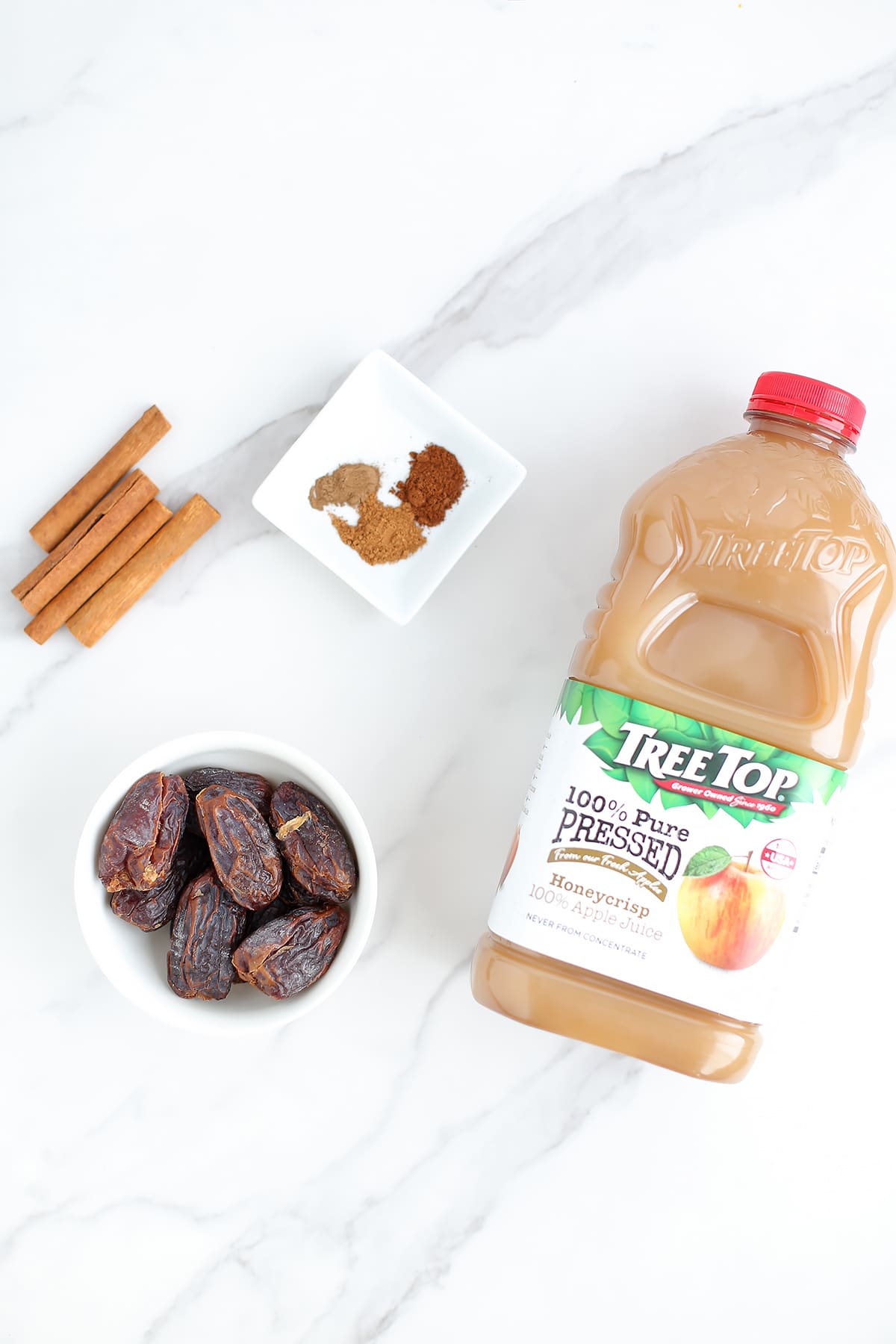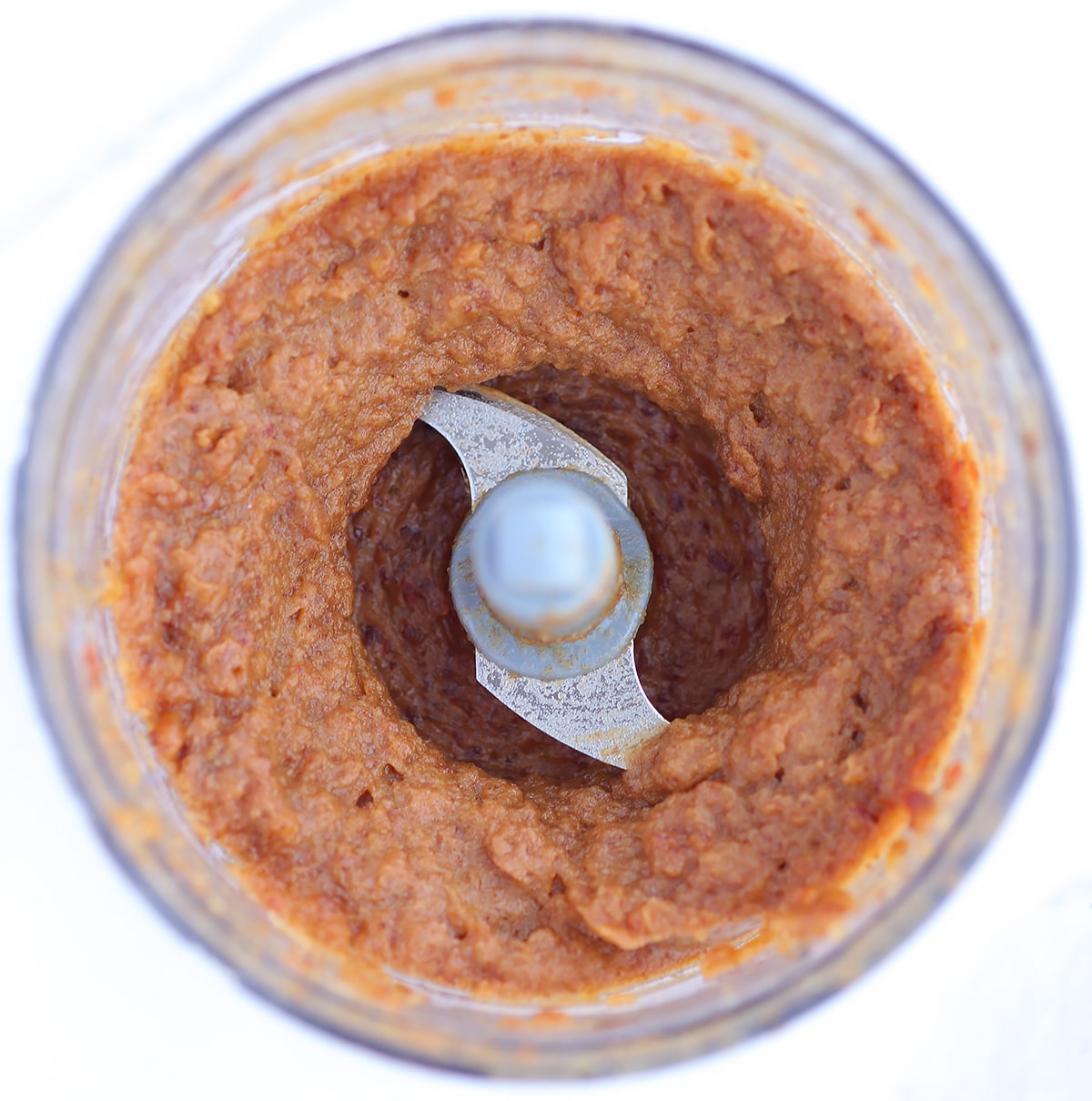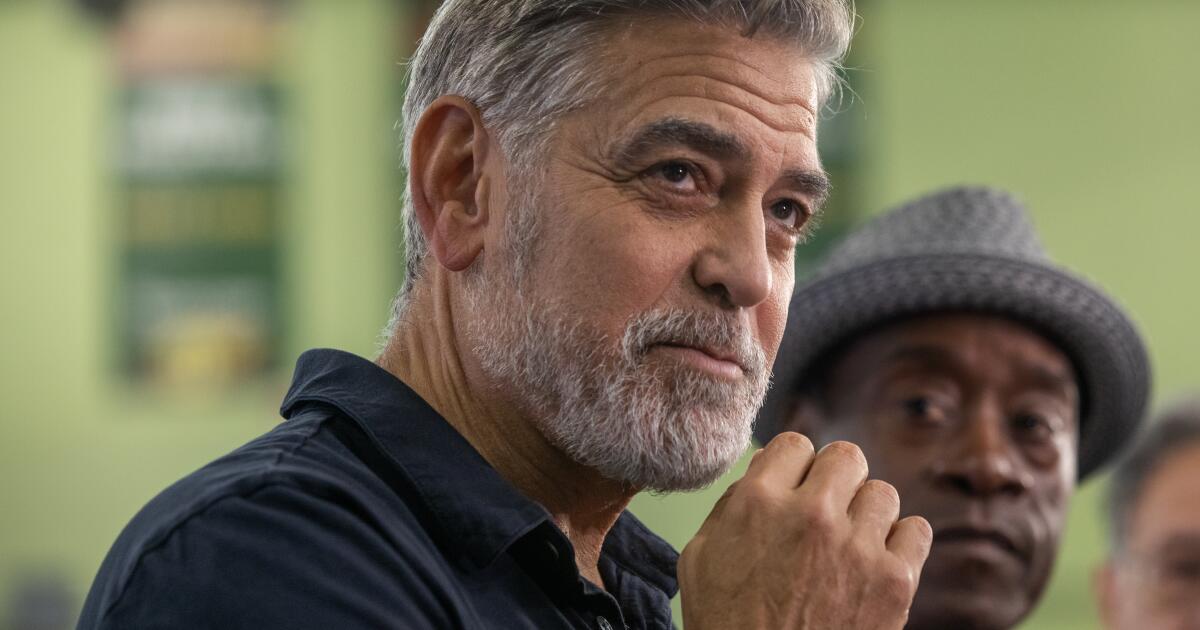Health
Caramel Apple Cider – Super Healthy Kids

This delicious and comforting Homemade Caramel Apple Cider is absolute perfection. We sweetened it with pureed dates, giving it a rich caramel flavor. It is spiced just right, not too sweet, and is one of our favorite ways to warm up on cold nights.
The Very Best Caramel Apple Cider
I know that hot chocolate probably holds the title as the most popular beverage on cold winter nights. But for me personally- I’ll choose a warm mug of spiced cider any day of the week. For the past few years, I’ve been using date caramel to sweeten my apple cider. It adds the perfect amount of sweetness, a rich caramel flavor, and thickens it just so (not to mention a boost of fiber and antioxidants). It’s absolutely delicious and so easy to make.

Ingredients You’ll Need to Make Caramel Apple Cider:
- Apple Juice– We used 100% pure pressed apple juice. Avoid using apple juice with added sugars.
- Dates– We use Medjool dates to sweeten this caramel apple cider. It adds a delicious caramel-like richness and thickens the cider ever so slightly. It’s delicious!! You don’t get any ‘date’ flavor. However, you can sweeten with brown sugar if you prefer.
- Cinnamon Sticks– We simmered our cider with cinnamon sticks, but you could also add a teaspoon of ground cinnamon.
- Ground cloves, allspice and cardamom– I found this to be the perfect combination of spices, but you can play around with your favorite combination. Ground nutmeg or ginger would also be yummy!

How to Make Caramel Apple Cider:
- Make the date caramel. Add 8 -10 pitted dates and 1/4 cup water to a high speed blender. Puree until smooth, adding additional water a bit at a time if necessary. Set aside.
- Make the cider. In a large saucepan, add the apple juice, cinnamon sticks, and ground spices. Bring to a boil, then reduce the heat to medium low and simmer for 20 minutes.
- Add the caramel. Whisk in about half of the date caramel. Taste, and add additional caramel until you reach desired sweetness.
- Serve. Pour the cider into serving mugs. Top with whipped cream and ground nutmeg if desired. Enjoy!


Tips & Suggestions
Use other sweeteners:
If you don’t want to use date caramel, you can also sweeten your apple cider with brown sugar or maple syrup.
How to soften hard dates:
If your dates have become too hard, don’t toss them! Simply put the dates in a medium sized bowl and add enough boiling water to cover them. Allow to soak for at least 10 minutes. Drain the water and proceed with the recipe.
Serving Suggestions:
We coated the rims of our mugs in cinnamon sugar to add an extra little something. Completely unnecessary, but that’s the fun of it! To do this, add some apple juice (or water) to a shallow bowl. To another shallow bowl, add about 1/4 cup of granulated sugar and 1/2 teaspoon ground cinnamon. We also added a bit of turbinado sugar for a bit of sparkle. Stir to combine. Take the rim of your mug and dip it into the apple juice. Allow the excess to drip off, then roll it in the cinnamon sugar.
We then topped our apple cider with whipped cream, ground nutmeg, a drizzle of caramel, and a thin slice of apple.
Store leftover date caramel in an airtight container in the fridge for 1-2 weeks.


Looking for More Delicious Recipes?
Caramel Apple Cider
This delicious and comforting Homemade Caramel Apple Cider is absolute perfection. We sweetened it with pureed dates, giving it a rich caramel flavor. It is spiced just right, not too sweet, and is one of our favorite ways to warm up on cold nights.
Calories: 192kcal
- 8 cups apple juice Use 100% pure pressed apple juice
- 1/4 teaspoon ground cloves
- 4 each cinnamon sticks
- 1/8 teaspoon allspice
- 1/8 teaspoon cardamom
- 10 medium dates, Medjool You can sub 1/2 cup brown sugar
- 1/4 cup water
-
Bring first five ingredients to a boil in a large pot.
-
Reduce heat; cover and simmer on low-medium for 20 minutes.
-
To make date caramel, blend 8 -10 pitted dates with 1/4 c. water in a high speed blender until smooth.
-
Whisk in the date caramel to simmering cider. Serve warm with whip cream on top. Enjoy!
Calories: 192kcal | Carbohydrates: 50g | Protein: 1g | Sodium: 8mg | Fiber: 4g | Sugar: 43g
www.superhealthykids.com

Natalie Monson
I’m a registered dietitian, mom of 4, avid lover of food and strong promoter of healthy habits. Here you will find lots of delicious recipes full of fruits and veggies, tips for getting your kids to eat better and become intuitive eaters and lots of resources for feeding your family.
Health
How to Survive a Heat Wave on a Fixed Income



By Gautama Mehta, Grist
“This story was originally published by Grist. Sign up for Grist’s weekly newsletter here.”
Mone Choy is 68 and lives in the New York City neighborhood of Inwood, at the northern tip of Manhattan, on a fixed disability income of $1,901 per month. Her rent is frozen at $1,928. She lives with chronic health issues that render her unable to work. In addition to a few other intermittent gigs, Choy covers the rest of her expenses by collecting bottles from her building’s recycling and taking them to a nearby redemption center.
One luxury her budget doesn’t leave room for, even during a heat wave like the one that scorched the city last week — and remains ongoing around the world — is air conditioning. She has several AC units in her apartment (gifts from friends concerned about Choy’s health) but because she can’t afford to turn them on, they sit uninstalled.
“When I experience heat, my blood pressure shoots up and I get dizzy,” Choy said. To keep cool on hot days, Choy has to find air-conditioned spaces elsewhere in the city. To do so, she relies on a resource that the city government has touted as central to its response to extreme heat: the several hundred “cooling centers” that open across the city when a heat advisory is issued. These are listed on a city website, with a map of accessible sites. Almost all of the cooling centers are in libraries and senior and community centers. The list also includes museums, Salvation Army locations, and Petco stores.
Last Friday, Choy woke up at 4:30 a.m., three hours before the heat would make her apartment unbearable, to pack everything she would need for her day’s journey into a shopping cart. She assembled her lunch, snacks, incontinence supplies, and an extra change of clothes in case of an unexpected lack of bathroom access. “I don’t have extra money to … buy something I forgot,” she said.
Next, she checked the weather report and transit system service alerts, and planned her route. “I take the cooling center information and put that together with my own personal knowledge of senior centers and the ones I think are better funded and less liable to have broken toilets — that happens because a lot of senior centers are located in NYCHA [public housing] buildings.”
She makes her choice of senior center based on its proximity to one of the city’s publicly listed Privately Owned Public Spaces, or POPS. These are spaces inside private buildings like corporate offices, and they are usually made accessible to the public by the site’s developer as part of a deal with the city, in exchange for zoning concessions. Choy says the cooling centers located at senior centers tend to close early for cleaning — “you’re pushed out by 4:00, 4:30 — 5:00 if you’re lucky, the hottest part of the day.” The privately owned centers generally stay open until 9:00 or 10:00. After she’d packed her bags on Friday, Choy left home at 6:00 to catch the bus to St. Peter’s Church in Midtown, where she planned to stay until it closed.
There were about five other people using the senior center as a respite from the heat, but more seniors came in at lunchtime for the free meal it offered. Normally, Choy is a very sociable person and likes to chat with the other visitors, but on Friday she didn’t feel up to conversation. She said she was “fatigued and resentful and just in a place of general low grade dread. I’m going, ‘It shouldn’t be like this in June, so I’m dreading what July and August will be like.’” At the cooling center, she passed her time reading the news on her phone and feeling increasingly dispirited.
One place she’d love to be on a hot day is a library — she loves to read, and it’s an environment where “you don’t have to put up with people giving off crazy energy you don’t wanna be around.” But in her neighborhood, Choy said, the library was closed to make way for a new apartment building. It’s been replaced with a temporary library that lacks a public bathroom.
Heat waves have put a spotlight on the waning fortunes of New York City libraries, which have become a cultural battlefront in municipal politics under the administration of the city’s mayor, Eric Adams. In November, Adams announced budget cuts to the library system that ended Sunday services at libraries citywide. During the negotiations for next year’s budget — for which the deadline is this Sunday — he proposed further cuts to the library system that would have had the likely effect of closing most libraries’ doors on Saturdays as well as an additional $125 million from the libraries’ capital budget, which is the source of funding for repairs to library HVAC systems.
The library cuts have been the source of protests and opposition from the City Council — and yesterday, the intense backlash appeared to bear fruit. In a dramatic eleventh-hour reversal, the mayor agreed to reverse last year’s library budget cuts, restoring funding that would likely allow Sunday service to resume at libraries citywide. It is not yet clear whether the new budget will include the $125 million in capital budget cuts from libraries.*
In a press conference before the heat wave, Adams said, “Global warming is real and we want to make sure that climate change and the heat that it brings with intensity, that people are aware of how to deal with it during a heat wave.” He touted the online map of cooling centers and mentioned that the sites included “many of our public libraries.”
In a landmark 2002 book, “Heat Wave: A Social Autopsy of Disaster in Chicago,” about the 1995 heat wave that killed more than 700 people and prompted the formation of New York’s cooling centers, the sociologist Eric Klinenberg established that access to social infrastructure and public space helped determine which neighborhoods had the most deaths. He later served on a New York City climate planning commission called PlanYC, where, he told Grist, he “advocated for the city to supercharge its branch libraries … so that they could be updated with heat and air conditioning systems that worked reliably and converted into emergency relief centers during extreme weather.”
In his view, the city’s current approach is a far cry from that vision. “Mayor Adams has consistently shown that the library is not a priority when it comes to city services. And so as I see it, it’s hypocritical for his administration to tell New Yorkers they can rely on the library during a dangerous heat wave, when they’ve essentially made it impossible for New Yorkers to rely on the library in their daily lives,” Klinenberg said.
But the Adams administration has reacted touchily to criticisms that it’s undermining its own heat relief efforts with the library budget cuts. Last week, Brad Lander, the city’s comptroller, noted that, on the first day of the heat wave last week, all the city’s libraries — 41 percent of the cooling centers — were closed because Juneteenth was a federal holiday. Zachary Iscol, the commissioner of emergency management, who oversees the cooling centers, took to social media to call the comptroller’s comments “a pretty significant misrepresentation.”
Lander told Grist the figure came directly from the city’s data on its cooling centers, which his office analyzed in a 2022 report. That report also found that fully half of the cooling centers were listed as closed on Saturdays, and 83 percent were closed on Sundays.
“We are not currently investing in the civic infrastructure that we need to keep people safe in the climate crisis anywhere near as much as we know we need to. The libraries are the biggest example of that,” Lander said.
Last Friday afternoon, Choy decided to leave the senior center to buy a bag of ice. As soon as she stepped outdoors, she said, “I just remember getting instantly sweaty. It was hard to breathe and I was so grateful that the little drugstore was right across the corner and I didnt have far to walk. I stayed in the store for 15 minutes before I made my purchase. I felt my heart starting to beat really fast; I didn’t want that to move into a lightheaded situation.”
She went back to the senior center and stayed there until 3:30, when the cleaning staff began spraying down the tables and she felt unwelcome. It was 94 degrees out, but because she had already bought the bag of ice to cool her down for the trip back to Inwood, Choy decided to ride the bus back uptown instead of walking to the nearby POPS. When she got there, she sat in the air-conditioned Manhattan Mini Storage locker she rents for around a dollar a day and stocks with books and bottled water.
Some 350 people die annually of heat-related causes in New York City. Only a handful of these cases are heat-stress deaths, or those directly caused by heat. In most cases, the heat exacerbates people’s existing illnesses and comorbidities. Among the most important risk factors, according to city data, is access to home air conditioning — and the funds to turn it on.
“Given that extreme heat is by far the deadliest impact of climate change already — and, sadly, very likely to be much more so in the years to come — we are nowhere near where we need to be in getting ready for it,” said Lander.
In what should ostensibly be a straightforward policy solution, the state offers low-income residents help with heating and cooling their homes through its Home Energy Assistance Program — but the assistance offered through this program heavily skews toward heating. The limited funds available for cooling assistance can only be used to buy an air conditioner, not to pay for running it — and what’s more, these funds tend to run out early every summer. Choy carefully monitors her power usage to ensure she doesn’t spend more than the low-income subsidy she receives from her power company, Con Edison. “If I go over, then I have to carry a balance, and then now you have to deal with the rules of ConEd. Do they want to do a payment arrangement? How long do they let you go with arrears,” she said.
Choy’s apartment takes a while to cool down, even after temperatures outside have subsided. So at around 8:30, once it had cooled down enough for Choy to feel comfortable outdoors, she left the storage center and sat on a bench in her neighborhood. At 11:30, she headed home and went to sleep, prepared to repeat the day’s journey in the morning.
New York City is only at the beginning of what is expected to be an unusually hot summer. Temperatures usually climb in July and August, and could also be increased by a La Niña weather cycle. For Choy, this means more trekking between cooling centers, and in her experience, she sees a signal of what’s in store for many more people — particularly the indigent, elderly, and disabled — as global temperatures rise.
“I don’t think a lot of people make this connection, but I’m purposefully claiming myself to be a climate refugee,” Choy said. “I feel like I’m a canary in the mine. The way I live every summer, it’s how a lot of people are going to have to live.”
*Update, June 28, 11:35 am: This article has been updated to reflect the latest developments in New York City’s 2025 budget negotiations.
This article originally appeared in Grist at https://grist.org/extreme-heat/how-to-survive-a-heat-wave-on-a-fixed-income/.
Grist is a nonprofit, independent media organization dedicated to telling stories of climate solutions and a just future. Learn more at Grist.org
—
This story was originally published by Grist.
***
You Might Also Like These From The Good Men Project
Join The Good Men Project as a Premium Member today.
All Premium Members get to view The Good Men Project with NO ADS. A $50 annual membership gives you an all access pass. You can be a part of every call, group, class and community. A $25 annual membership gives you access to one class, one Social Interest group and our online communities. A $12 annual membership gives you access to our Friday calls with the publisher, our online community.
Register New Account
Need more info? A complete list of benefits is here.
—
Photo credit: unsplash
Health
Properly Treating, and Recovering, From Pediatric Sports Injuries



Pediatric sports injuries are common year-round, with a particular increase seen in the summer and fall seasons.
While there’s no sure way to ensure your child doesn’t get hurt during sporting events, there are steps you can take to help them make an effective, and full, recovery.
Here, University of Michigan Health C.S. Mott Children’s Hospital’s orthopaedic surgeon and sports medicine specialist, Eileen Crawford, M.D., provides tips on how best to help your kids heal.
What types of kid’s sports injuries should you be on the look out for?
Crawford: Various types of injuries can happen with any sport, but some injuries are more commonly associated with specific activities.
In contact or collision sports, traumatic injuries such as ligament tears, meniscus tears and fractures are most common.
Sports such as swimming, rowing and running see more overuse injuries from the repetitive motions that are required.
Pitching in baseball and softball and gymnastics require repeated high stress on the joints that can cause damage to the bone or cartilage.
While these are the common types of injuries we see in these sports, it doesn’t mean that they are the only injuries that occur in a given sport.
How can you help prevent kid’s sports injuries?
Proper conditioning, stretching and warm ups are important for preventing sports injuries.
Children should work on building core strength, balance, flexibility and good body mechanics to help prevent them from becoming injured.
While it isn’t the fun part of participating in youth sports, it can make it easier to avoid or bounce back from injuries.
Exercises that keep the body ready to fight against injury aren’t always built into youth sports practices, so it’s worth talking to coaches or getting your child involved in a supplemental exercise program if they aren’t doing that type of training with the team.
Sports sampling, for instance, is an excellent way for kids to fully develop their body control and agility. It allows kids to play different sports at various times of the year, aiding in their overall development.
If your child is injured, how do you know when to take them to the emergency room or schedule an appointment with their pediatrician?
Certain injuries require immediate attention.
These include a loss of consciousness (even brief), difficulty breathing, abdominal pain from a sports injury, visual changes, knocked out teeth, vomiting from an athletic event, blood in the urine or stool, and the deformity of a limb. All of these warrant an emergency department evaluation or urgent consultation by your kid’s primary care provider.
Rapid swelling or bruising of a body part you suspect is broken should be evaluated promptly as well (within a few days of the injury), but might not require an ED visit if no deformity or open wound is present.
Injuries that are more gradual in their onset of pain, have symptoms that only occur while participating in certain activities, and/or seem to be of muscular origin, can wait to be treated in clinic by a primary care provider.
For injuries that appear gradually, begin treating them when symptoms occur by using ice, over-the-counter pain medications, such as acetaminophen or ibuprofen, compression and rest.
If pains persist, make sure that your child sees a physician to evaluate the symptoms in case there’s an injury or disorder that won’t get better by using these treatments alone.
What are common mistakes and misconceptions about kid’s sports injuries?
A very common mistake [we see] is parents diving into online resources before consulting with a physician or other care provider and getting a diagnosis.
While having readily available internet access makes this easy to do, it can lead to lots of misinformation about the injury and how to treat it.
Talk to your doctor first, get the correct diagnosis, and then ask your doctor to direct you to trustworthy resources.
If you’re unsure if your child’s diagnosis is correct after seeing a care provider, get a second opinion before getting too far into online resources.
It’s also a mistake to put too much stock in the experiences of your kid’s friends or acquaintances who have had, what seems, like the same injury.
Injuries can vary greatly in severity, and children recover at different rates. Looking to the experiences of others can be useful to give some peace of mind and guidance, but it’s important to remember at that your child is individual and needs to be treated in the way that is best for them. Talking with your doctor about these experiences can help set appropriate expectations for your child.
Another common mistake that’s seen in youth sports injuries is placing your child back into sports too soon.
Children are remarkably quick and effective healers if they do it right the first time. Not properly healing from a childhood injury can set children up for long term issues later in life. It’s better to be patient with their healing than push the limit to get them back into sports too early.
How can you support your child through a sports injury?
While it can be challenging, you should try to stay positive and calm, even if you expect the worst. This will help your child process this journey as well as have confidence in their ability to heal.
After an injury, you should check in with your child frequently about their physical and mental health. Having an injury that takes them out of sports for a while can be mentally challenging for children since they miss time with their teammates, feel like they’re falling behind, and may feel some loss of identity.
Their mental state will most likely shift over the course of the recovery period, and discussing their emotions surrounding the injury with them will help them process the situation.
It’s also very helpful for your kids to have activities outside of sports.
When your child’s identity is solely tied to athletics, an injury that takes them away from sports is much more devastating than when the child can turn to other activities, hobbies and social groups.
Physical therapy is additionally, and often, a major component in the recovery process.
Whether it’s physical therapy in a clinic, or working on physical therapy exercises at home, it’s important to make sure your child is doing the proper exercises recommended to them to ensure a successful recovery.
If possible, and they have one, parents can also work with their kid’s athletic trainer in that particular sport. Athletric trainers have specific knowledge about the sport your child plays and typically know your child as well, so they can provide useful information on how your kid can [best] prepare to return to their sport after an injury and also work with them on techniques to get back up to speed once they’ve returned.
For more information from University of Michigan Health Sports Medicine, visit Sports Injuries and Sports Medicine or University of Michigan Health MedSport.
—
This post was previously published on MICHIGANMEDICINE.ORG under a Creative Commons License.
***
You may also like these posts on The Good Men Project:
Join The Good Men Project as a Premium Member today.
All Premium Members get to view The Good Men Project with NO ADS.
A $50 annual membership gives you an all access pass. You can be a part of every call, group, class and community.
A $25 annual membership gives you access to one class, one Social Interest group and our online communities.
A $12 annual membership gives you access to our Friday calls with the publisher, our online community.
Register New Account
Need more info? A complete list of benefits is here.
—
Photo credit: iStock.com
Health
Work-Related Nerve Injuries Are Common With Repetitive Motions



Although you may not always realize it, many of the jobs you do can put strain on, and even cause damage to, your nerves.
Sandra Hearn, M.D., the associate chair of Education and Professional Development in the Department of Physical Medicine and Rehabilitation, and a team of collaborators, set out to better understand the causes of occupational nerve injuries.
What is an occupational nerve injury?
An occupational nerve injury refers to a problem with your peripheral nerves that’s caused by a work-related activity. It’s often seen in manual labor jobs.
Hearn and her team conducted a review that focused specifically on the injuries that occur over time through repetitive motion.
“While some injuries involve unpredictable accidents, like having a limb crushed in machinery or having a vehicle accident at work, we looked at more predictable mechanisms that can injure nerves where they are vulnerable,” Hearn said.
“These mechanisms often involve repetitive trauma with damage to the nerves over time.”
According to Hearn, nerve injuries presenting within the context of specific tasks at work give researchers information about how a common mechanism, across different individuals, can manifest in pathology.
“When we look beyond overt crush injuries or lacerations, we find that several biomechanical stressors underlie many occupational nerve injuries, regardless of which body part is affected,” she said.
“These can include compression, stretch, vibration, and repetitive or high-force movements of regional muscles and joints.”
The paper’s findings
The review found that workers whose jobs required manual labor were most likely to be at risk for an occupational nerve injury. More specifically, jobs that required repetitive movements with high force, such as lifting heavy loads, heavy hammering and repeated squatting, were at the highest of risk.
Although some of these injuries can have an abrupt onset, meaning you can pinpoint when you got hurt and when your symptoms started. But others can occur gradually over time and with continued repetition.
While some injuries involve unpredictable accidents, like having a limb crushed in machinery or having a vehicle accident at work, our review focuses on predictable mechanisms that can injure nerves where they are vulnerable.
“Many of these injuries present as a cumulative trauma situation, without a clear moment of injury,” said Hearn. “For example, it could be that someone has used a jackhammer for many years and starts to develop a syndrome of waking up in the morning with the hands numb.”
Hearn says one of the most surprising findings was how specific anatomic variants can predispose your nerves to a greater risk of injury.
“Where a common mechanism exists, anatomic variation can often explain why some workers experience a nerve problem and others do not,” Hearn said. “The chances of an individual becoming injured depends on how their nerves respond to the repetitive task.”
Each work-related injury is unique. That’s why Hearn and her team aimed to learn about the best way to approach the majority of these common work-related injuries so that they could create a reference guide that would work to treat as many patients as possible.
“We recognize that today, occupations and the specific tasks they require, are very diverse. Creating a list of all possible job tasks and associated nerve injuries is essentially impossible,” said Hearn.
Their goal, now instead, is to equip clinicians to recognize, when treating workers with possible nerve-related problems, where and how biomechanical factors may interact with the anatomy to damage nerves.
“This understanding can be applied even when patients describe occupations and tasks that vary from those presented in the review. It offers the community plausible diagnoses and appropriate treatments for patients with these work-related nerve injuries.”
Additional authors include Shawn P. Jorgensen M.D., Joelle M. Gabet M.D., and Gregory T. Carter, M.D.
Paper cited: “Occupational Nerve Injuries,” Muscle and Nerve. DOI: 10.1002/mus.28099
Sign up for Health Lab newsletters today. Get medical tips from top experts and learn about new scientific discoveries every week by subscribing to Health Lab’s two newsletters, Health & Wellness and Research & Innovation.
Sign up for the Health Lab Podcast: Add us on Spotify, Apple Podcasts or wherever you get you listen to your favorite shows.
—
Previously Published on michiganmedicine.org with Creative Commons License
***
You Might Also Like These From The Good Men Project
Join The Good Men Project as a Premium Member today.
All Premium Members get to view The Good Men Project with NO ADS. A $50 annual membership gives you an all access pass. You can be a part of every call, group, class and community. A $25 annual membership gives you access to one class, one Social Interest group and our online communities. A $12 annual membership gives you access to our Friday calls with the publisher, our online community.
Register New Account
Need more info? A complete list of benefits is here.
—
Photo credit: iStock
-

 African History5 years ago
African History5 years agoA Closer Look: Afro-Mexicans 🇲🇽
-

 African History6 months ago
African History6 months agoBlack History Facts I had to Learn on My Own pt.6 📜
-

 African History5 years ago
African History5 years agoA Closer Look: Afro-Mexicans 🇲🇽
-

 African History1 year ago
African History1 year agoMajor African Tribes taken away during the Atlantic Slave Trade🌍 #slavetrade #africanamericanhistory
-

 African History1 year ago
African History1 year agoCameroon 🇨🇲 World Cup History (1962-2022) #football #realmadrid #shorts
-

 African History5 months ago
African History5 months agoBlack History Inventors: Mary Kenner 🩸
-

 African History1 year ago
African History1 year agoNo African pre-Columbus DNA? 🤯🤯 #history #mesoamerica #mexico #african
-

 African History1 year ago
African History1 year agoPROOF AFRICAN AMERICANS AIN'T FROM AFRICA DOCUMENTED EVIDENCE
























